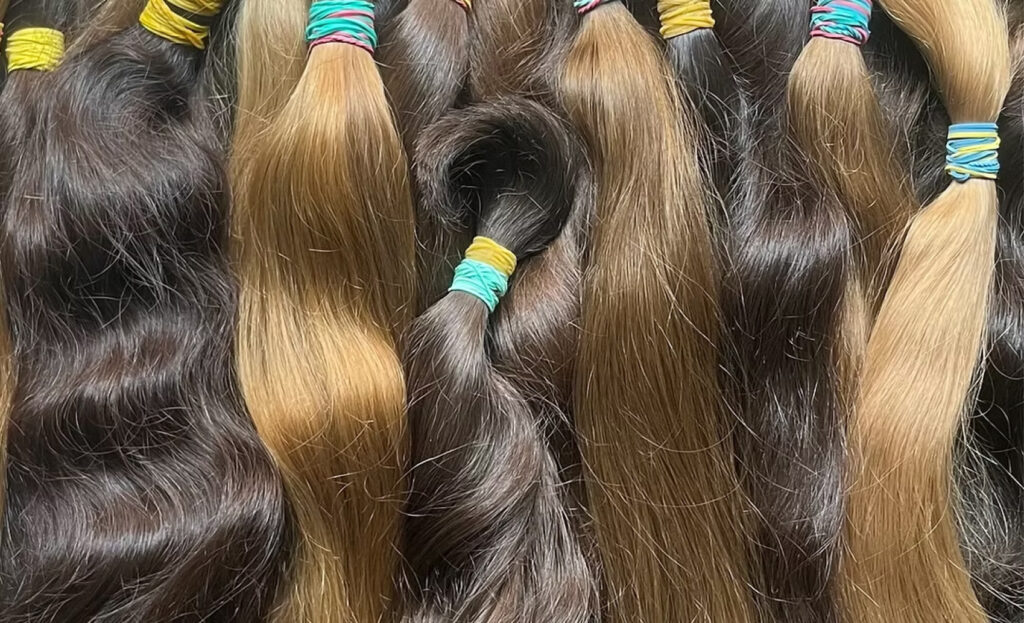If you’re new to wearing hair extensions, you might wonder why the term “Remy hair extensions” keeps coming up. There’s nothing mystical about it—Remy simply means that all the hairs in a bundle, weft, or wig are running in the same direction, from root to tip.
Why Does This Matter?
Hair is covered in tiny cuticles that naturally flow in one direction—think of them like fish scales or roof tiles. When all the hairs align, the cuticle layer acts like a protective force field, giving hair its shine, strength, and smooth texture.
But when cuticles run in mixed directions, those harmless little scales become your worst nightmare. They rub against each other, creating a backcombed effect—not in a glamorous, tousled way, but in a tangled, matted mess that no amount of brushing, conditioning, or oiling can fix.
What If Hair Didn’t Have Cuticles?
You can buy hair that has had the cuticle stripped off. In theory, this prevents tangling even if the strands get mixed up. Sounds good, right? Wrong.
The cuticle is vital for hair’s health, shine, and longevity. Removing it compromises the hair’s structure and overall quality. If it weren’t so important, all commercial hair would be cuticle-free. But high-quality hair leaves the cuticle intact, even though it’s harder to process and more expensive to produce.
So, Are Remy Hair Extensions Always Good?
Not necessarily. Remember: Remy just means the hair is aligned from root to tip. While you should only buy Remy hair extensions, being Remy alone doesn’t guarantee high quality.
What matters just as much is:
- The ethnicity of the hair
- The care taken during manufacturing
- The “draw” (evenness in length) of the bundle
Bottom line:
All good hair extensions are Remy, but not all Remy hair extensions are good.
Let’s Talk About Silicone
Do a quick image search for “Remy hair extensions.” You’ll find page after page of ultra-sleek, glossy strands in every shade and curl pattern imaginable. What do they all have in common? They’re shiny. Too shiny—almost like Barbie hair. That’s not natural. That’s silicone.
Silicone is a slippery, shiny, heat-resistant liquid polymer used to coat hair extensions.
- In small amounts, it adds a healthy sheen.
- In large doses, it transforms dull, dry strands into glossy perfection.
But here’s the catch: Silicone washes off. And once it does, the hair reverts to its original state—usually dry, brittle, and knot-prone.
Do Remy Extensions Have Healthy Cuticles?
You’d think so—but not always.
Many so-called “European grade” or “Euro-style” Remy hair extensions are actually made from Asian hair with much of the cuticle removed. Why?
- Processing – Partially removing the cuticle makes the hair easier to process.
- Texture – It makes the hair finer, more similar to European hair, which increases its market value.
These extensions are often coated in silicone for a shiny, soft finish. But when the coating wears off, the hair can become dry, dull, and prone to breakage.
If you’re looking for long-lasting, reusable, premium-quality hair, partially cuticle-removed extensions likely won’t meet your expectations.
How to Spot Authentic European Hair
Real European hair is:
- Rare
- Expensive (comparable in price to genuine Russian hair)
- Varied in colour and texture
If you’re buying pre-packed extensions that all look identical in length, colour, and density—it’s almost certainly processed Asian hair, not true European.
What Are Non-Remy Hair Extensions?
Non-Remy hair extensions are typically made from “standard” or fallen hair—shed hair collected from:
- Hairbrushes
- Drains
- Salon floors
- Even landfill sites
Some women save their shed hair for years, storing it in bags to sell once they have enough. Yes, really.
This hair is then:
- Teased apart and sorted by length
- Mixed from multiple donors
- Chemically processed with acid baths to remove most of the cuticle
- Bleached, coloured, styled, and heavily coated in silicone
Because the cuticles aren’t fully removed, the hair tangles once the silicone washes away—often becoming unusable within a short period.
Why You Should Invest in Quality Hair Extensions
Removing 100% of the cuticle is time-consuming and costly, which is why it’s rarely done thoroughly. But when it comes to hair extensions, the saying rings true:
You get what you pay for.
If a deal seems too good to be true, it probably is. Always choose ethically sourced, high-grade Remy hair from a reputable salon or supplier.


